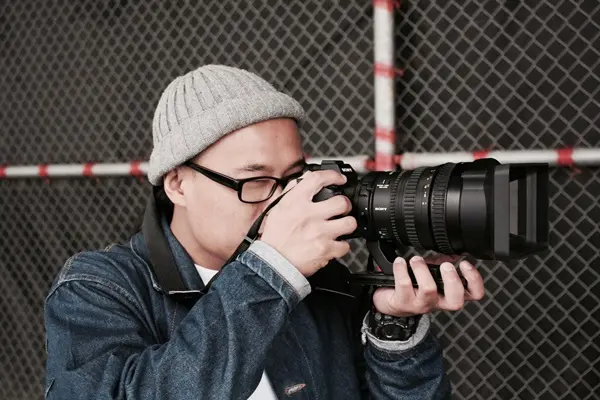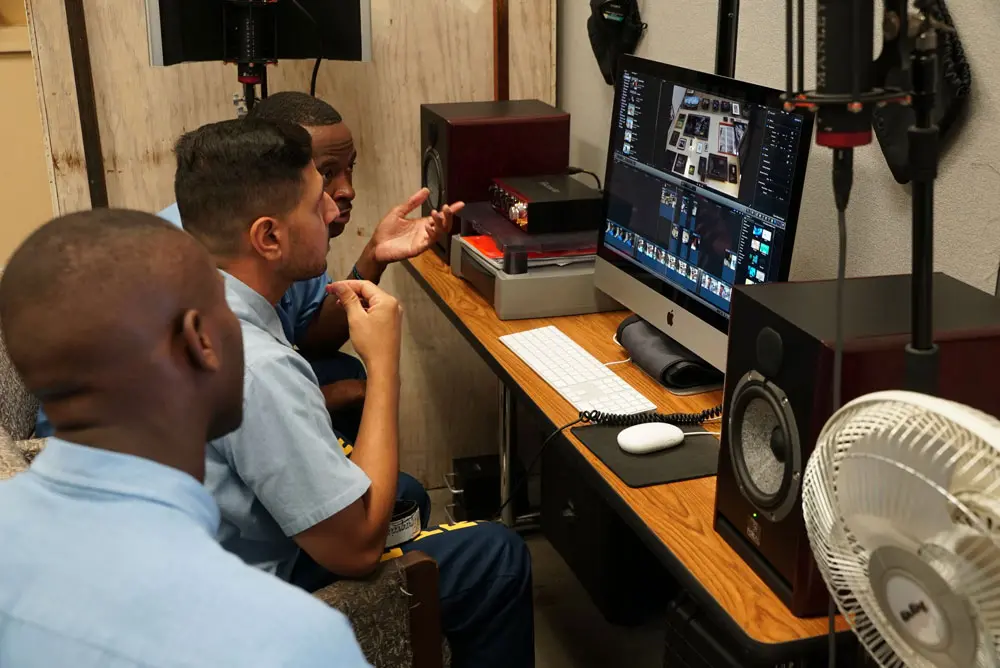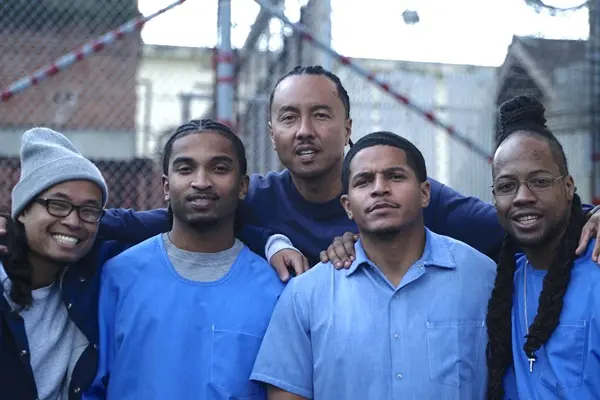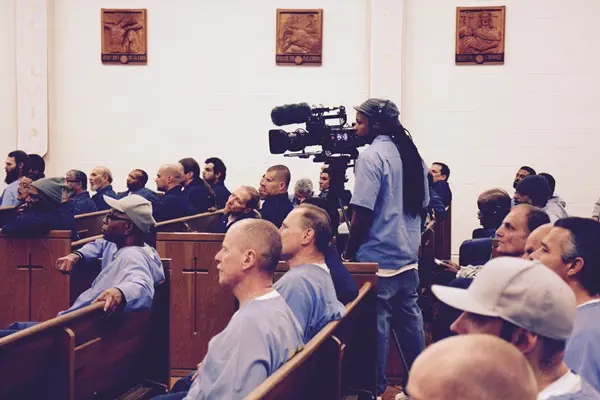On an ordinary day a year ago, Adamu Chan and Thanh Tran could be found making short videos together with a group of filmmakers. One of the team’s most popular videos documents the comedic struggles of making a peanut butter and jelly sandwich. Another one is a parody of MTV Cribs, a TV show that took viewers inside celebrities’ homes.
“I’m gonna show you my bedroom, my kitchen, my study, and my living room,” a man says before beckoning for the camera to follow him, not into a celebrity’s impressive mansion, but into a cramped 4-foot-by-9-foot cell. That’s because Chan, Tran, and their fellow filmmakers are part of FirstWatch, a filmmaking program run entirely by people incarcerated at San Quentin State Prison in California.
San Quentin is unique among prisons in the United States for the amount of rehabilitative programs it offers, including academic and vocational courses, drug and alcohol treatment programs, and classes on everything from gardening to yoga. In addition to FirstWatch, the prison’s media center is home to a newspaper called the San Quentin News and the podcast Ear Hustle.
But for the past 13 months, the media center hasn’t been home to anything. Most nonessential programs have been shut down while San Quentin is on lockdown due to the COVID-19 pandemic.
Although such measures are intended to mitigate the effects of the virus on incarcerated populations, they also present a different set of dangers. In many prisons, lockdowns drastically limit access to mail, phones, food, and contact with loved ones on the outside. Some experts say they also can lead to increased violence.
And after more than a year — and hundreds of thousands of cases in prisons around the country — these protective procedures are also raising questions about the very purpose of incarceration.
“I believe the most important aspect, the goal of incarcerating people, is supposedly rehabilitation,” Tran says.
With all therapy, educational, and arts programs inactive, opportunities for incarcerated people to participate in many rehabilitative activities are virtually impossible. Add in thousands of people sick with a deadly virus, lack of proper protective equipment, and the inability to social distance effectively, and prisons like San Quentin become danger zones where sickness, death, and punishment run rampant.
COVID-19 reaches San Quentin
The pandemic has had an outsize effect on prisons around the country. According to data collected by The Marshall Project, over 381,000 coronavirus cases have been reported among the incarcerated in federal and state prisons across the United States since last March, as well as over 102,000 cases among prison staff.
The situation in California is no different. The positive test rate in the state’s prisons is almost five times that of the state’s non-incarcerated population and the death rate is 1.5 times the statewide COVID death rate.
Last spring, prisons across California went into lockdown in an effort to limit the spread of the virus. As case numbers climbed across the state, San Quentin managed to make it almost three months without a single reported case among the incarcerated. By May 31, however, the numbers had begun to rise — slowly at first and then rapidly. By the end of June, the prison was the site of over 1,000 active cases.
Numerous sources attribute the outbreak to a decision by the California Department of Corrections and Rehabilitation (CDCR) to transfer almost 200 men from the California Institution for Men (CIM) to San Quentin in late May; cases began rising almost immediately after their arrival. According to the San Francisco Chronicle, these men were not tested for the virus before the transfer took place. Several days earlier, the CDCR had identified 700 high-risk individuals at CIM and prioritized them for transfer to other prisons; it is unclear whether those transferred to San Quentin were a subset of this group.
To date, there have been 2,238 positive cases among people incarcerated at San Quentin. The 2020 Statistical Report from San Quentin lists 3,636 total incarcerated people as of May 2020, just before the outbreak. Although the prison’s population has shifted somewhat during the last year, this still means that more than half of the people incarcerated at San Quentin were infected with the virus over the course of the summer. More than 10% of deaths across California’s 35 state prisons occurred at San Quentin.
Like more than 2,000 of his peers, Thanh Tran contracted COVID-19 during the outbreak. “I was left to die in a cell,” says Tran. “That’s not an understatement because I have friends here who have passed away.”

Thanh Tran, one of FirstWatch's filmmakers, holds a camera. Tran contracted COVID during the outbreak at San Quentin this summer. Image courtesy of Re:Store Justice. United States. 2019.
Beyond the physical effects of the pandemic
As coronavirus case numbers have increased in prisons across the country, so has public awareness about the health of incarcerated populations, including dialogues about prioritizing prisons in vaccine rollout.
But the effects of the coronavirus on the United States’ prison population goes far beyond the physical, often in ways that remain fairly invisible to those on the outside.
Rehabilitative programs are a significant part of prison life for many incarcerated people. But in most prisons around the country, these programs have faced severe limitations or ceased to function at all since last spring. The effort to adapt programming to comply with lockdown regulations has been inconsistent, depending on the specific prison and program topic.
Some writing-based classes have been able to send modified lesson materials to participants through the mail, while several others have experimented with Zoom or outdoor classes. For arts programs like FirstWatch that rely on collaboration, hands-on learning, or specific equipment, any temporary solutions have been largely ineffective and many programs have had no choice but to remain inoperative.
While they are often seen as less essential than educational classes or 12-step programs, studies show that prison arts programs play a key role in changing behavior. Some studies find a correlation between participation and reduced recidivism, although others are less conclusive. Even so, these programs have been proven by multiple studies to reduce institutional misconduct, as well as improve participants’ relationships with each other and with correctional staff.
Larry Brewster, an emeritus professor at the University of San Francisco, has spent decades conducting research on prison arts programs. His findings demonstrate that such programs develop participants’ social skills, cultivate their ability to complete projects, and give them opportunities to collaborate with others. They also change participants’ conceptions of themselves, helping them to discover talents and attributes they were unaware they possessed. This improved self-confidence also increases the likelihood that they will pursue other educational opportunities, his studies show.
“They felt agency, they felt empowered, they felt entrusted, really most of them for the first time,” Brewster says of the prison artists he has met through his research. “When they entered that classroom or that studio space [...] those other identifiers melted away and what became first and foremost of importance was ‘I’m a painter. I’m a musician.’”
Lesley Currier is the co-founder and managing director of Marin Shakespeare Company, which runs Shakespeare programs at San Quentin and multiple other California prisons. She believes that arts classes, and theater programs in particular, allow participants to approach rehabilitation in a physical way that traditional programs do not.
“In prisons there are a lot of classes that are called things like ‘Alternative to Violent Thinking’ [...] that try to get people to recognize their own thinking patterns so that they can change them so that they’ll act differently and feel better about themselves,” Currier says. “[In theater] we say, ‘Let’s just act differently. That’s going to make us feel differently and then we’re going to start thinking differently.’”

A group of FirstWatch filmmakers edits a project in San Quentin's media center prior to the pandemic. Image courtesy of Re:Store Justice. United States. 2018.
Currier has witnessed firsthand the way that these hands-on, collaborative arts programs can not only change incarcerated people’s behavior but their entire lives.
“We’ve seen people drop out of gangs, reunite with family members, start creating their own art, writing, and performing plays,” Currier says. “They can live in a place where they’re more interested in accessing their creativity and their self expression than they are in participating in the kind of negative behavior that is rampant in our prison system.”
But Currier and her colleagues have not been able to enter a prison since March 2020. While the rehearsal room remains empty, they have had to provide alternate programming by distributing packets and workbooks to participants who then send their written work back to them.
Whether the absence of prison arts programs during the pandemic will have a negative effect on behavior remains to be seen. Incarcerated people have primarily been concerned with fear of the virus itself — especially due its rapid spread in crowded prison environments, as well as because of the substandard medical care provided to those who do contract COVID. But inactive participants also echo Brewster’s observations, noting the importance of these programs to their rehabilitation and suggesting that they would have mitigated the uncertainty and fear of the past year.
“These are the things that are kind of essential to having a life and having a healthy kind of sense of yourself while you live in this really terrible, dehumanizing place,” Chan says.

The FirstWatch team prior to the pandemic. Adamu Chan (back row) was released from San Quentin this past fall. Image courtesy of Re:Store Justice. United States. 2019.
A connection between the inside and the outside
Like many of us, incarcerated individuals are looking for a way to make sense of what has happened to them during this pandemic. But as long as arts programs like FirstWatch lie dormant, many lack a clear way to heal, to process their grief, and, perhaps most importantly, to tell the stories of the past year to the outside world.
“Within a two-month period, July and August, almost 30 people died [at San Quentin],” Chan says. “It was a historic moment and a historically tragic moment. And I think it’s important to document that. I think it’s important for people to remember it. And I think it’s an important healing tool.”
FirstWatch founder and restorative justice advocate Adnan Khan, who was resentenced and released from San Quentin in 2019, only experienced the outbreak affecting many of his friends from the outside.
He believes that, if FirstWatch’s filmmaking had been permitted to continue, the public would more fully understand the extent of the pandemic’s impact on San Quentin. “No one [on the outside] actually saw the day to day of what that looked like,” Khan points out. “Imagine a bunch of people […] sitting on cots, just sick, coughing, frail. It would really do something for us, in terms of being more active.”
“If FirstWatch were open right now, we’d be able to show a different side, to share a different story,” Tran says.
Even before the pandemic, sharing participants’ work with the public was a central part of many rehabilitative arts programs, whether through the internet, such as FirstWatch’s various video series, or through in-person theatrical performances and art showings. Even after artists have served their sentences, these programs play a central role in their transition back into society. Marin Shakespeare Company has hired several formerly incarcerated actors and they also have a returned citizens theater troupe.
For currently and formerly incarcerated artists, sharing their work with those on the outside has a dual purpose, providing incarcerated individuals with the chance to give back to society and helping the general public to see them in a different light.
Khan believes that filmmaking in particular can cultivate empathy and understanding between those on the inside and those on the outside. “You get to see their laugh lines,” he says. “People don’t think people incarcerated have laugh lines.”

A member of the FirstWatch crew films inside San Quentin prior to the pandemic. Image courtesy of Re:Store Justice. United States. 2019.
Looking to the future to the future
Case numbers are now declining in many prisons and corrections departments are in the process of distributing the vaccine to incarcerated populations and staff.
But the path to getting rehabilitative arts programs up and running again is far from straightforward. So far, program facilitators and participants have not been given a clear timeline for getting back in the same room. Social distancing guidelines, restrictions on visitors, and quarantined housing units all present additional challenges to the return of programs in full.
Even as the future of the programs remains uncertain, those involved are hopeful. “When this veil is lifted, and we all pray and hope it is sooner rather than later with the vaccine, I personally think that the programs will flourish again,” Brewster says.
Getting arts programs back in action again will require effort from all sides: facilitators, participants, correctional staff, and the public. But if the filmmakers of FirstWatch are any indication, incarcerated artists are more than ready to get back behind the camera or in the rehearsal room.
Thanh Tran wants to make short films to memorialize his peers at San Quentin who have died of the virus and to show that their lives had meaning.
Even though he was released from San Quentin in October, Adamu Chan still plans to use the skills he acquired through FirstWatch. “Whether it’s media or the arts, I think I want to use that experience to continue to highlight things that are going on inside of the prison,” Chan says.
Adnan Khan is looking beyond the pandemic to see how FirstWatch can address other issues that dominated conversation and activism in 2020. Discussions about mass incarceration cannot be separated from this year’s national dialogues about police reform. “We’ve seen police brutality [on] every corner of this country besides prisons,” he points out.
Khan and Chan’s desire to make a difference using the skills they have acquired through prison arts classes is not uncommon for program participants.
“People who [are in the] program do better while they’re in prison and are really far more equipped to deal with the challenges of life after prison,” Currier says. “Many people come out of prison just incredibly eager to give back to society, to help young people to be a positive part of their community, and with a huge understanding of how precious every minute of life is.”
Even after lockdowns end and programs start up again, the work will only be just beginning. The events of the past year have created new questions about what rehabilitation can and should look like in times of crisis. Incarcerated artists and their work will certainly be at the center of that conversation.














